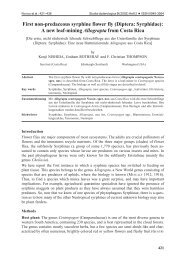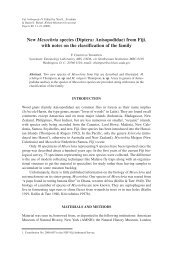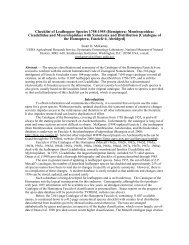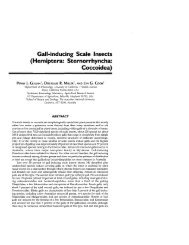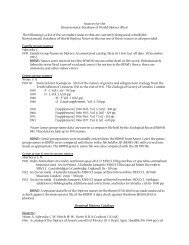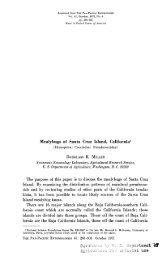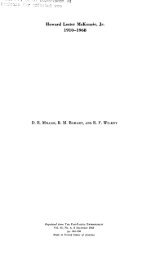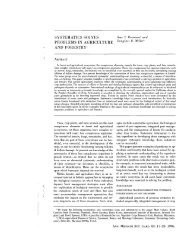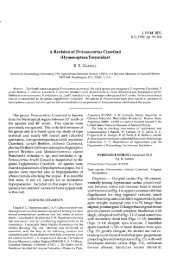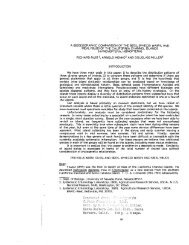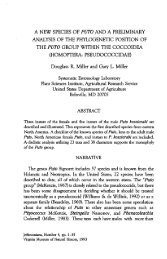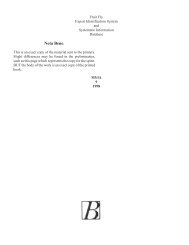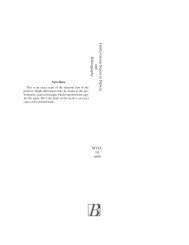Systematic revision of the Family Micrococcidae (Homoptera ...
Systematic revision of the Family Micrococcidae (Homoptera ...
Systematic revision of the Family Micrococcidae (Homoptera ...
You also want an ePaper? Increase the reach of your titles
YUMPU automatically turns print PDFs into web optimized ePapers that Google loves.
- 243<br />
Stem 16. Adult female with vulva on segment 6 (11a.l). Any instar with<br />
cruciform (bilocular) pores present (convergent with stems 3 and 11) (37.1).<br />
Stem 17. Adult female with spiracular setae present (convergent with<br />
Lecanodiaspis acaciae) (9.1); spiracular furrow with well defined row <strong>of</strong> pores<br />
(convergent with stem 10) (10.1); pores in spiracular plate surrounding atrium<br />
absent (reversal) (11.0).<br />
CONCLUSIONS<br />
The primary thrust <strong>of</strong> <strong>the</strong> analysis was to revise this unusual group <strong>of</strong> scale<br />
insects so that specimens collected in quarantine and elsewhere could be identified.<br />
We recognize two genera and eight species within <strong>the</strong> family <strong>Micrococcidae</strong>.<br />
Illustrations, descriptions and keys are presented for each species except<br />
for Micrococcus silvestrii which is described in detail in <strong>the</strong> paper preceeding<br />
this one (MAROITA et al. 1995).<br />
Ano<strong>the</strong>r thrust <strong>of</strong> this paper is to determine <strong>the</strong> relationships <strong>of</strong> Micrococcus<br />
and Molluscococcus with o<strong>the</strong>r scale taxa. Our results place <strong>the</strong> genera in a<br />
well-defined group <strong>of</strong> families that includes <strong>the</strong> Coccidae (Coccus hesperidum,<br />
Pulvinaria acericola, Sphaerolecanium prunastri), Aclerdidae (Aclerda arundinariae),<br />
and Tachardiidae (Tachardiella larreae). Numerous synapomophies<br />
associate Micrococcus and Molluscococcus with this group ra<strong>the</strong>r than with <strong>the</strong><br />
Eriococcidae or Pseudococcidae. The precise position <strong>of</strong> Micrococcus and<br />
Molluscococcus with <strong>the</strong> Aclerdidae and Coccidae is not as clear.<br />
Our analysis suggests that <strong>the</strong> genera are most closely related to <strong>the</strong><br />
Aclerdidae based on <strong>the</strong> structure <strong>of</strong> <strong>the</strong> penial sheath, aedeagus, and <strong>the</strong> unusual<br />
microtubular ducts found on <strong>the</strong> first instar. Unfortunately, <strong>the</strong> genital<br />
characters appear to be relatively simple, and <strong>the</strong> similarity <strong>of</strong> <strong>the</strong><br />
microtubular ducts may be artificial. Based on <strong>the</strong> fact that both <strong>the</strong><br />
Aclerdidae and <strong>the</strong> group comprising Micrococcus and Molluscococcus feed on<br />
monocotyledonous hosts, it seems logical that <strong>the</strong>se groups could be sister taxa.<br />
However, to provide more definitive information on <strong>the</strong> subject it is important<br />
to undertake a critical analysis <strong>of</strong> details <strong>of</strong> <strong>the</strong> various wax glands and pores.<br />
This analysis will require use <strong>of</strong> <strong>the</strong> scanning and transmission electron microscopes.<br />
It currently is'difficult or impossible to make informed homology decisions<br />
about <strong>the</strong>se important glandular structures using a light microscope. The<br />
Scanning Electron Microscope observations presented by MAROITA et al. (1995)<br />
are helpful in this regard, but more needs to be done with <strong>the</strong> ultrastructure <strong>of</strong><br />
<strong>the</strong> wax glands.<br />
It is our current position to consider Micrococcus and Mollu.scococcus to be<br />
a separate family, <strong>the</strong> <strong>Micrococcidae</strong>, ra<strong>the</strong>r than to incorporate <strong>the</strong>m in <strong>the</strong><br />
Aclerdidae. The latter approach would significantly modify <strong>the</strong> definition <strong>of</strong> <strong>the</strong><br />
Aclerdidae and would not take into account <strong>the</strong> possible superficial nature <strong>of</strong>



